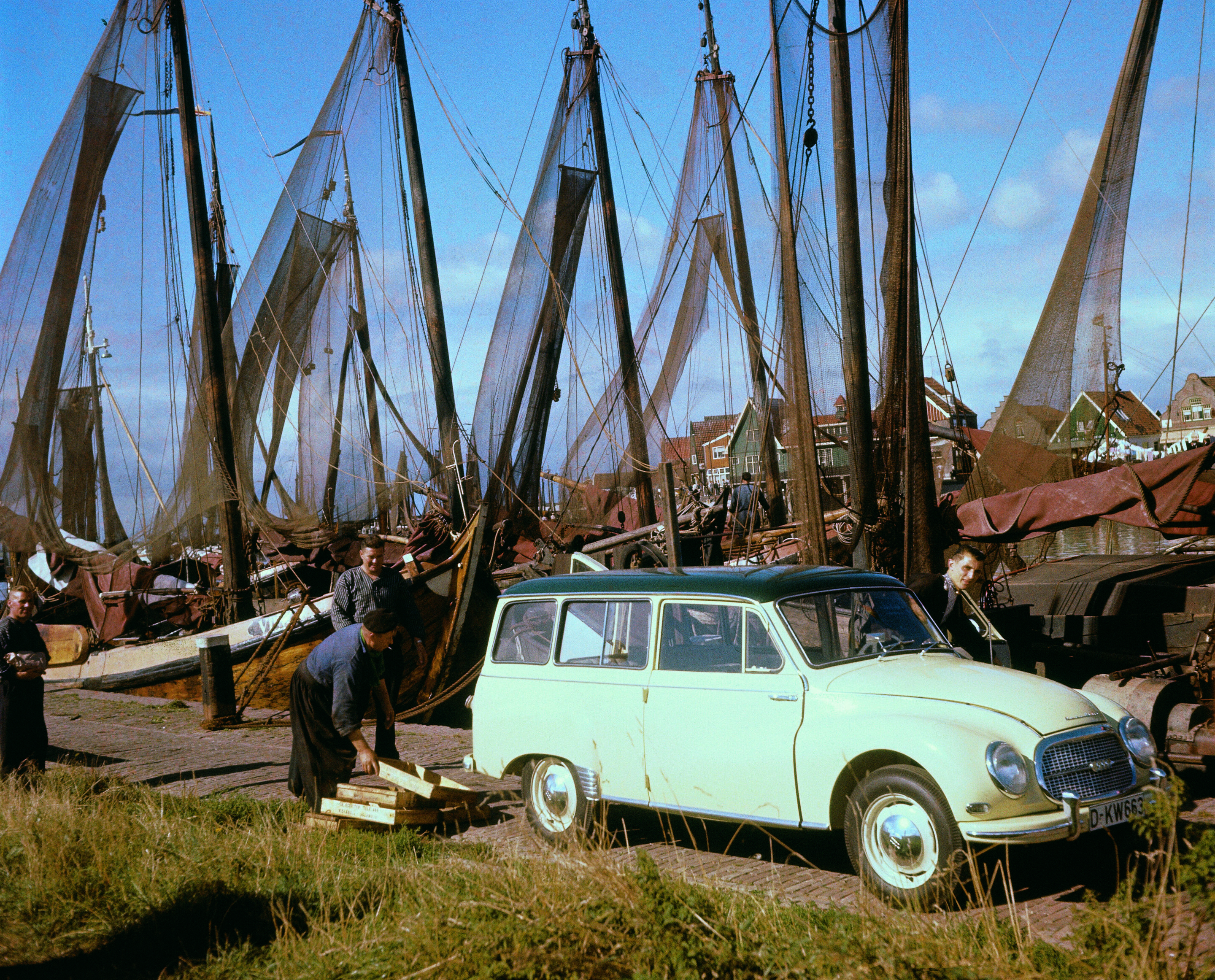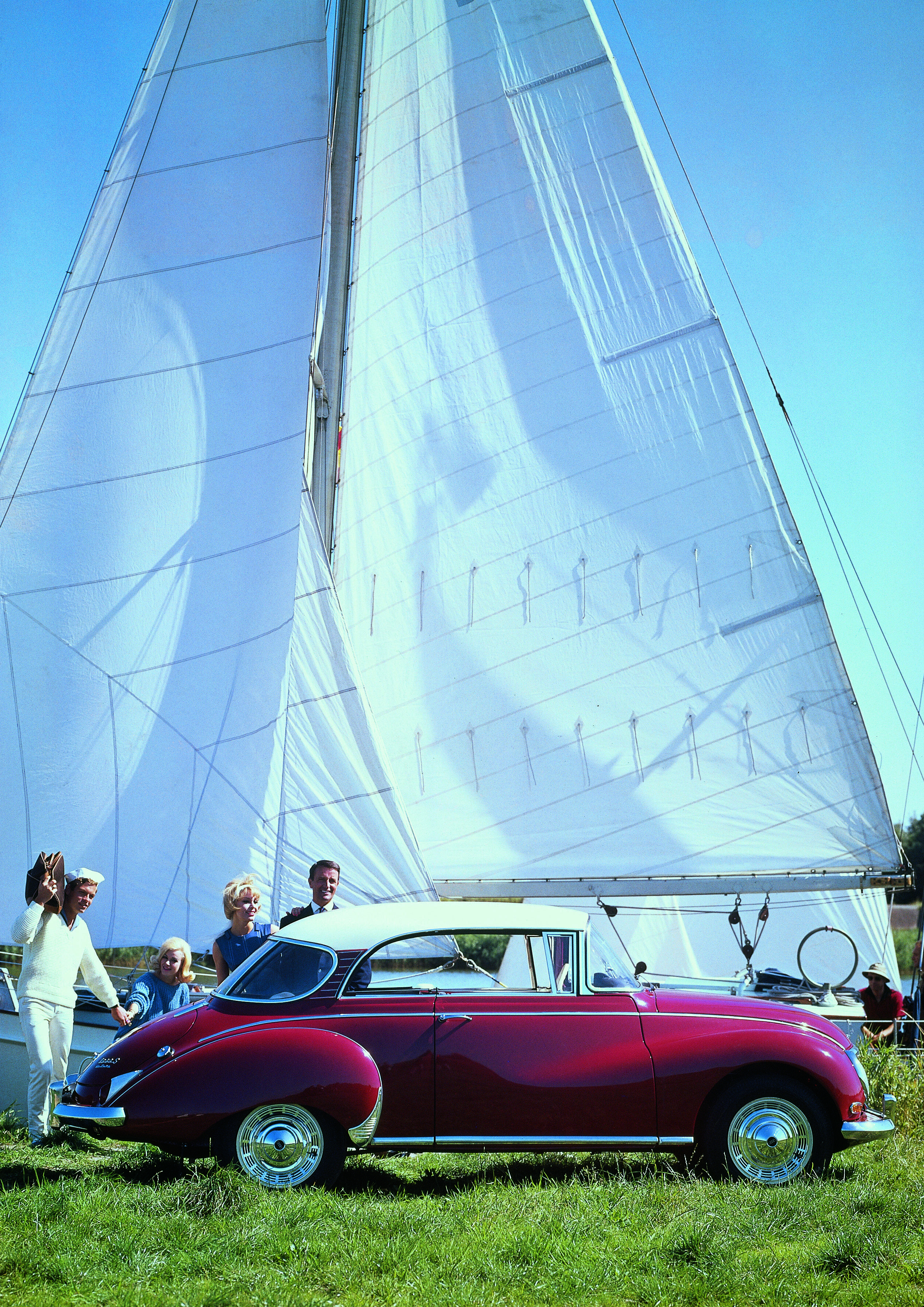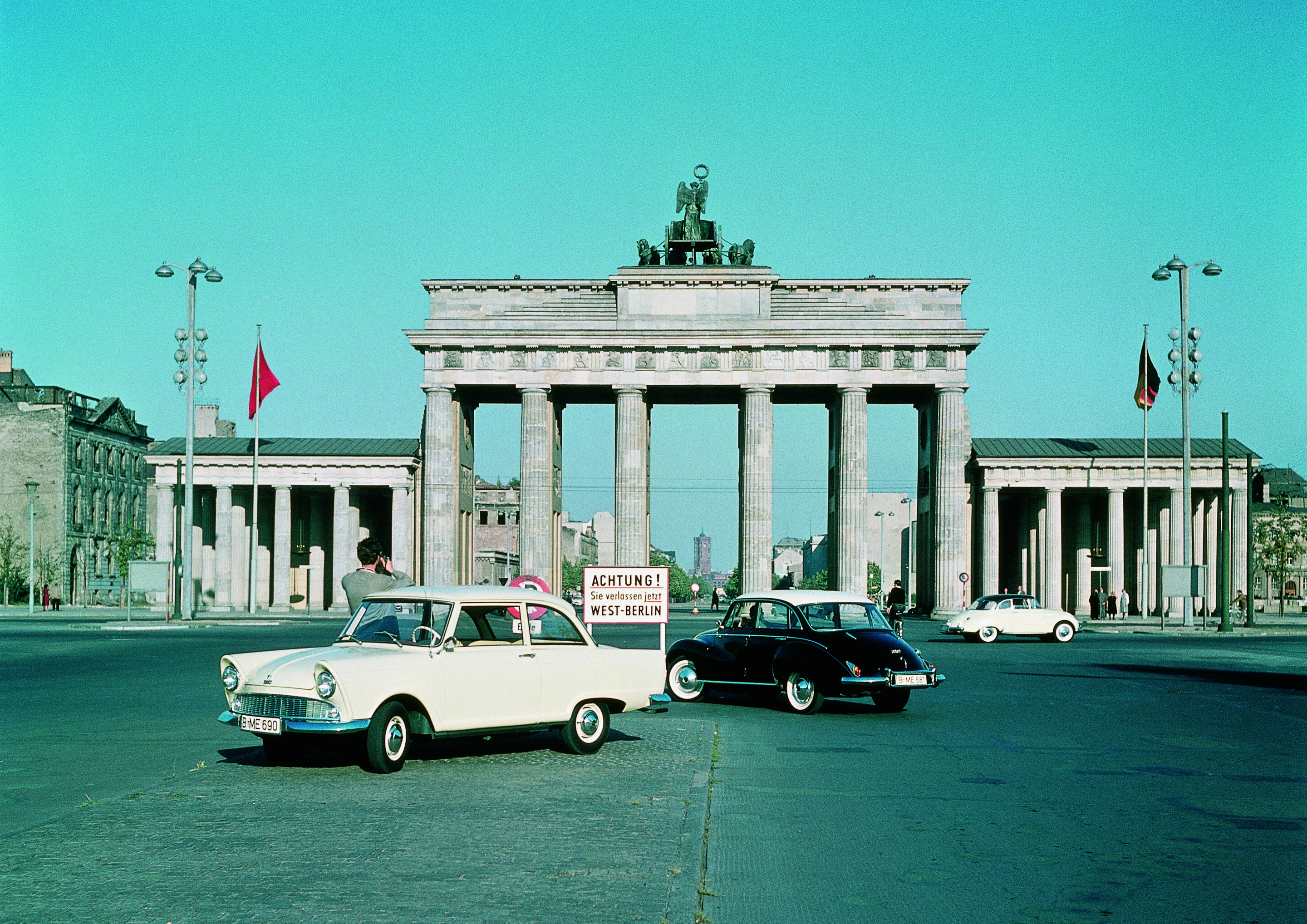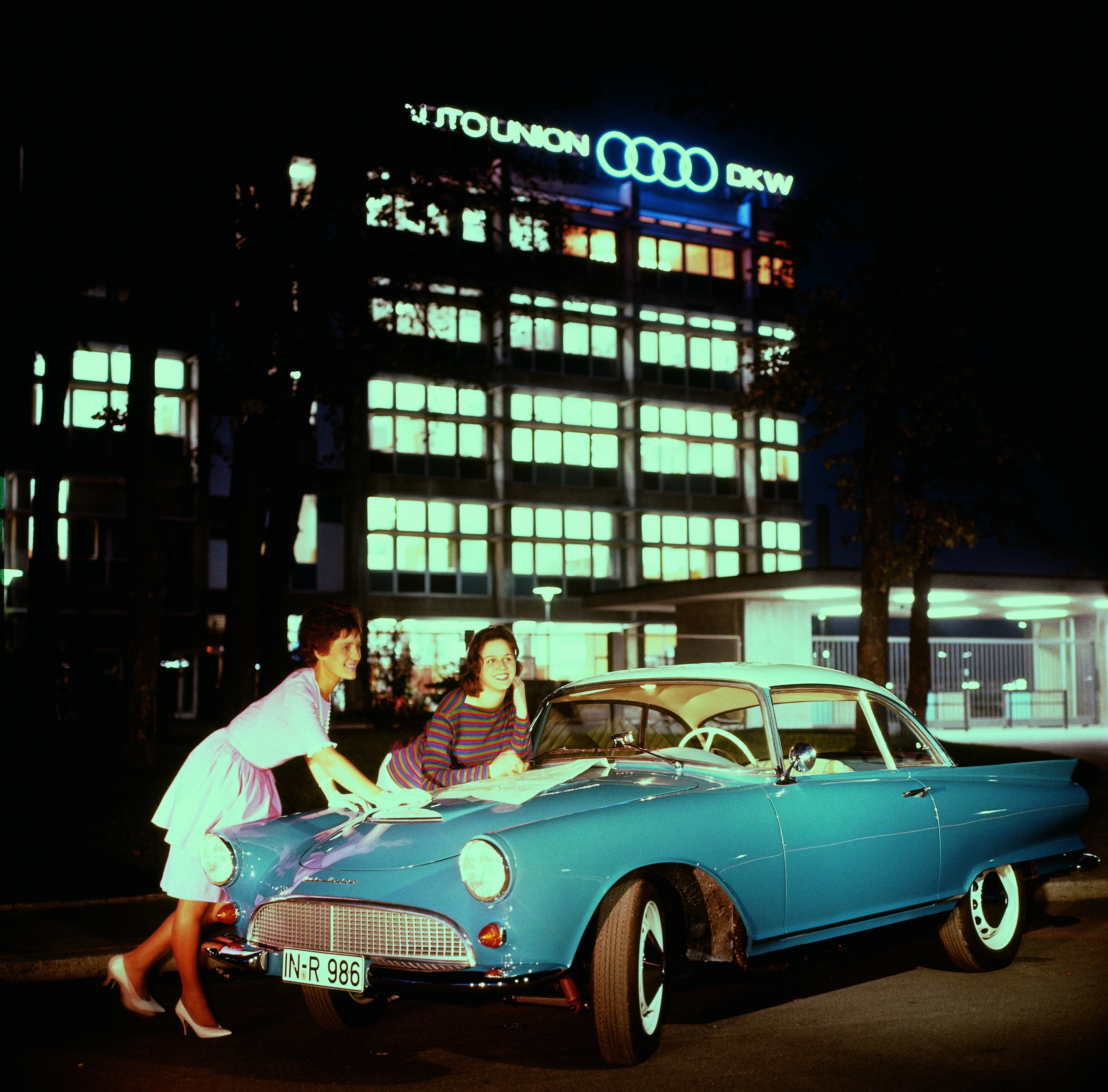Search
All search results for "Auto Union 1000S"
(22)
 Audi Tradition to commemorate numerous anniversaries in 2025
Audi Tradition to commemorate numerous anniversaries in 2025
With the “Auto Union Audi” vehicle, Auto Union GmbH revived the tradition-steeped Audi brand name in 1965. The new name was meant to show that this car represented a fresh start for Auto Union in terms of technology. The Audi was the first car from the brand with four rings to feature a four-cylinder four-stroke engine, and it marked the beginning of a new era in Ingolstadt. Twenty years later, on January 1, 1985, Audi NSU Auto Union AG was renamed AUDI AG, and since that time, the company and its products have shared the same short, memorable name. Ninety years ago, in February 1935, a spectacular attempt to break speed records took place in Italy. After test drives in October 1934 with the Grand Prix racing car on the AVUS in Berlin, the Auto Union racing department started developing the vehicle that would later be known as the “Lucca” car. Just a few weeks later, in December 1934, it was presented during initial test drives on the AVUS. The record attempts were planned in Hungary but were moved to Italy at the last minute due to bad weather. The one-kilometer and one-mile records were targeted to be broken with a flying start on a five-kilometer stretch between Pescia and Altopascio. Test drives took place on February 14, 1935, and the next day, on February 15, the car piloted by Hans Stuck performed as planned and was heralded the “world’s fastest road-going car.” With a speed of 326.975 km/h reached near Lucca, the vehicle broke 26 world records and 13 international class records.
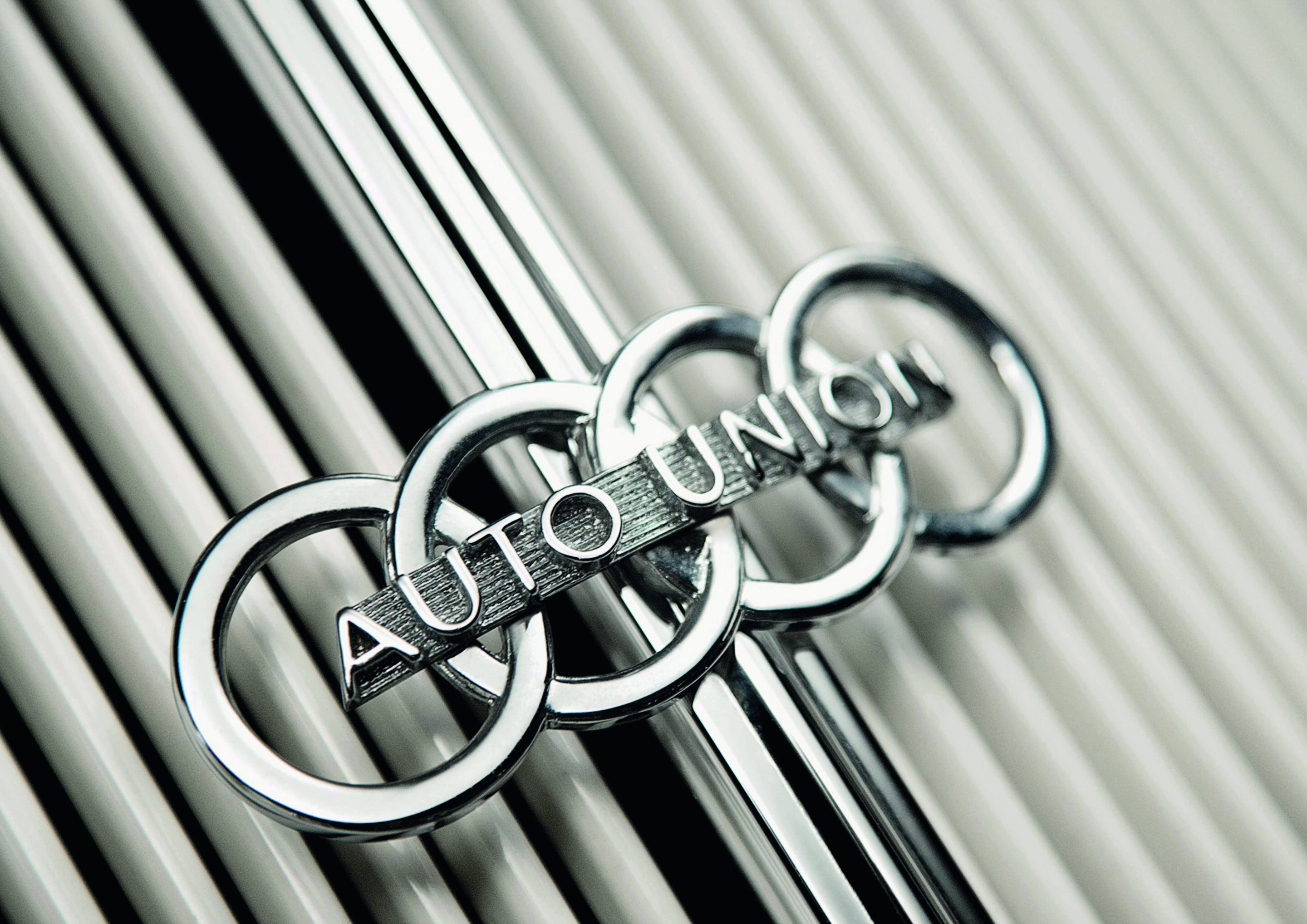 History of the Four Rings
History of the Four Rings
Outstanding victories on international racetracks – with stars such as Hans Stuck, Achille Varzi and, above all, Bernd Rosemeyer at the wheel – soon made the Auto Union, although founded only a short time before, known to the public worldwide. The world speed record run on the Frankfurt-Darmstadt ‘autobahn’ in October 1937, with Rosemeyer driving a streamlined version of the car, aroused enormous interest: he was the first person to drive a car on a public highway at more than 400 kilometres an hour. The races for which these ‘Silver Arrows’ were entered in the 1930s soon created a legend. Mercedes-Benz and Auto Union were almost unbeatable on the world’s racing circuits. In 1938 a three-litre formula was adopted, and the Auto Union sent its Type D, with 485-hp V 12 engine, to the starting line. After the death of Bernd Rosemeyer in the course of a further world speed record attempt in January 1938, the Italian driver Tazio Nuvolari took his place as the leading Auto Union driver. In addition to the powerful publicity effect obtained from its Grand Prix racing activities, the Auto Union also entered DKW motorcycles for races and cross-country events; specially prepared DKW and Wanderer sports cars took part in long-distance races such as Liège-Rome-Liège and in off-road reliability trials. Centralisation Just as the Auto Union initially retained the well-established product programmes of its individual brands, so the new group at first allowed prevailing business structures to continue. In its first years the group was run from Zschopau (DKW). In 1936 a new administrative building was completed in Chemnitz. From 1935 on, in parallel with the individual factories’ development departments, a central design office (ZKB) and a central experimental establishment (ZVA) were set up there. They developed and tested the group’s new models and their components from that time on, applying proven scientific methods more frequently than had been done previously.
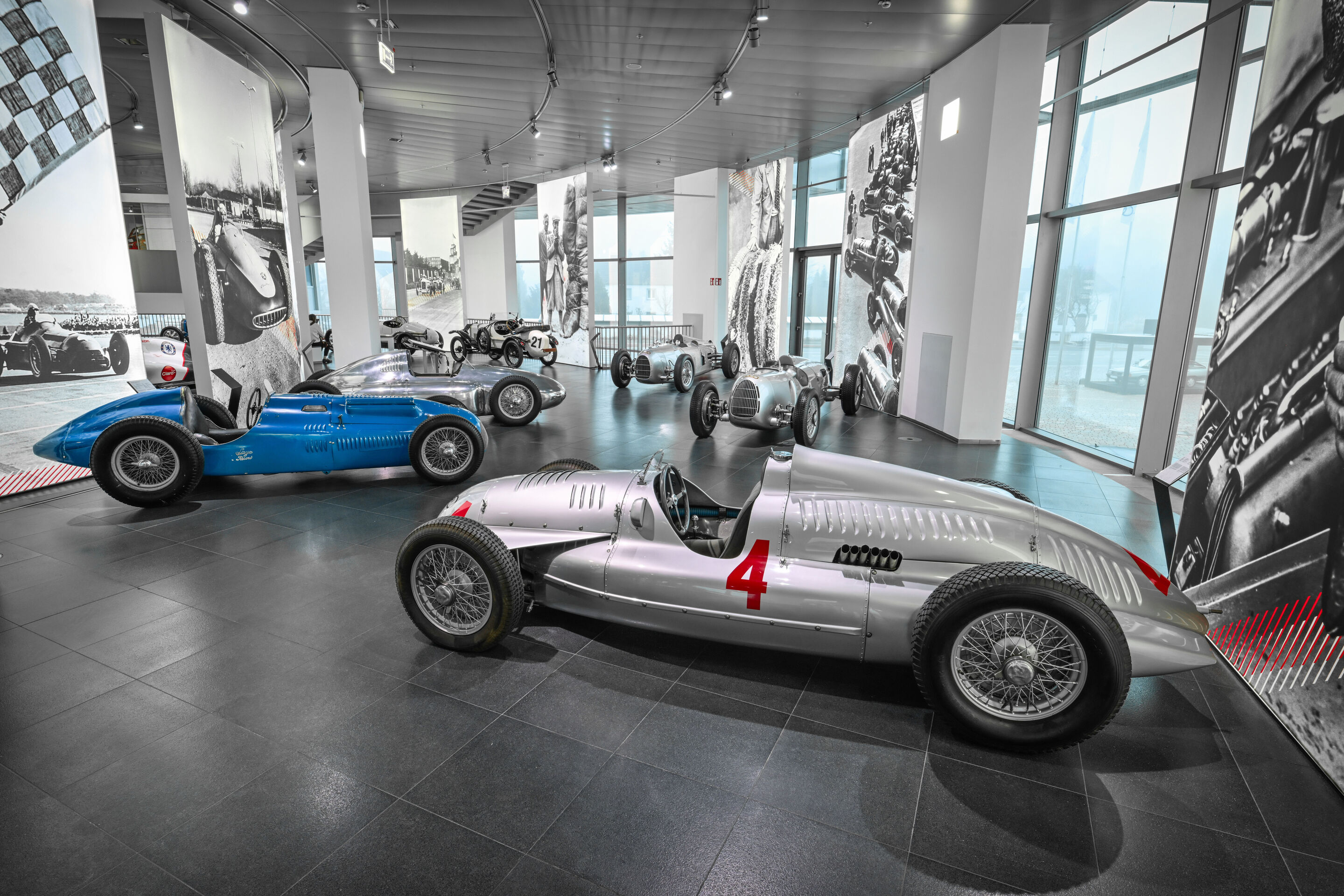 Dates
Dates
Audi Summer Concerts Program Presentation 2026 Audi museum mobile, Germany
February 26, 2026, 10:00 a.m. Start of presale Audi Summer Concerts 2026
February 26, 2026, 20:00 p.m. Jazz at the Audi Forum Ingolstadt: The Hit Stuff "Hot Seven" Jazzband Audi Forum Ingolstadt, Germany
March 2026
March 06, 2026, 7:30 p.m. Spring concerts Audi Bläserphilharmonie Liebfrauenmünster Ingolstadt, Germany March 19, 2026, 20:00 p.m. Jazz at the Audi Forum Ingolstadt: Blues for all Seasons Titilayo Adedokun Blues Band Audi Forum Ingolstadt, Germany
March 06, 2026, 7:30 p.m. Spring concerts Audi Bläserphilharmonie Basilika Straubing, Germany
April 2026
April 23, 2026, 8:00 p.m. Jazz at the Audi Forum Ingolstadt: Allotria Jazzband Audi Forum Ingolstadt, Germany
May 2026
May 08/09, 2026, 7:30 p.m. Spring concerts Audi Big band with Julie Brousset Halle neun Ingolstadt, Germany
October 2026
October 23, 2026, 7:30 p.m. Benefit concert Audi Bläserphilharmonie Festsaal Ingolstadt, Germany
November 2026
November 30, 2026, 7:00 p.m. Advent concert Audi Bläserphilharmonie St. Pius Ingolstadt, Germany
December 2026
December 11, 2026, 8:00 p.m. Audi Christmas concert Audi Forum Ingolstadt, Germany
 Anniversary Dates 2023
Anniversary Dates 2023
Heydekampf ................12 Autumn 1978 45 years Audi five-cylinder diesel engines ..............13 July 1973 50 years end of production of NSU Prinz 4 .............14 March 1973 50 years death of Fritz von Falkenhayn ..................15 December 1968 55 years end of production of DKW Munga, very last DKW ......................................................16 October 1963 60 years Ludwig Kraus joins Auto Union GmbH .......17 September 1963 60 years new products presented at Frankfurt IMS – NSU/Wankel Spider..............................................18 Contents Anniversaries in Our Corporate History Audi Tradition 3 Anniversary Dates 2023 September 1963 60 years new products presented at Frankfurt IMS – DKW F 12 und DKW F 12 Roadster ........................20 September 1963 60 years new products presented at Frankfurt IMS – DKW F 102 ..........................................................22 September 1963 60 years end of production of Auto Union 1000 .....23 May 1963 60 years bike production ceased in Neckarsulm ......24 April 1958 65 years takeover by Daimler-Benz, new plant, end of motorbike construction ..............................25 March 1953 70 years DKW F 91 three-cylinder model ...............27 October 1953 70 years NSU Quickly ............................................28 August 1948 75 years deletion of Auto Union AG .......................29 Spring 1933 90 years Audi Front ..............................................30 1928 95 years NSU 6/30 and NSU 7/34 .........................31 1873 150 years foundation of NSU ................................32 Audi Tradition 4 Anniversary Dates 2023 1988 35 years Audi 200 TransAm ..................................33 1983 40 years Hannu Mikkola, World Rally Champion .....34 1978 45 years Audi Motorsport .....................................35 June 1938 85 years Ewald Kluge wins the Lightweight TT on DKW ........................................36 January 1938 85 years Bernd Rosemeyer suffers fatal accident
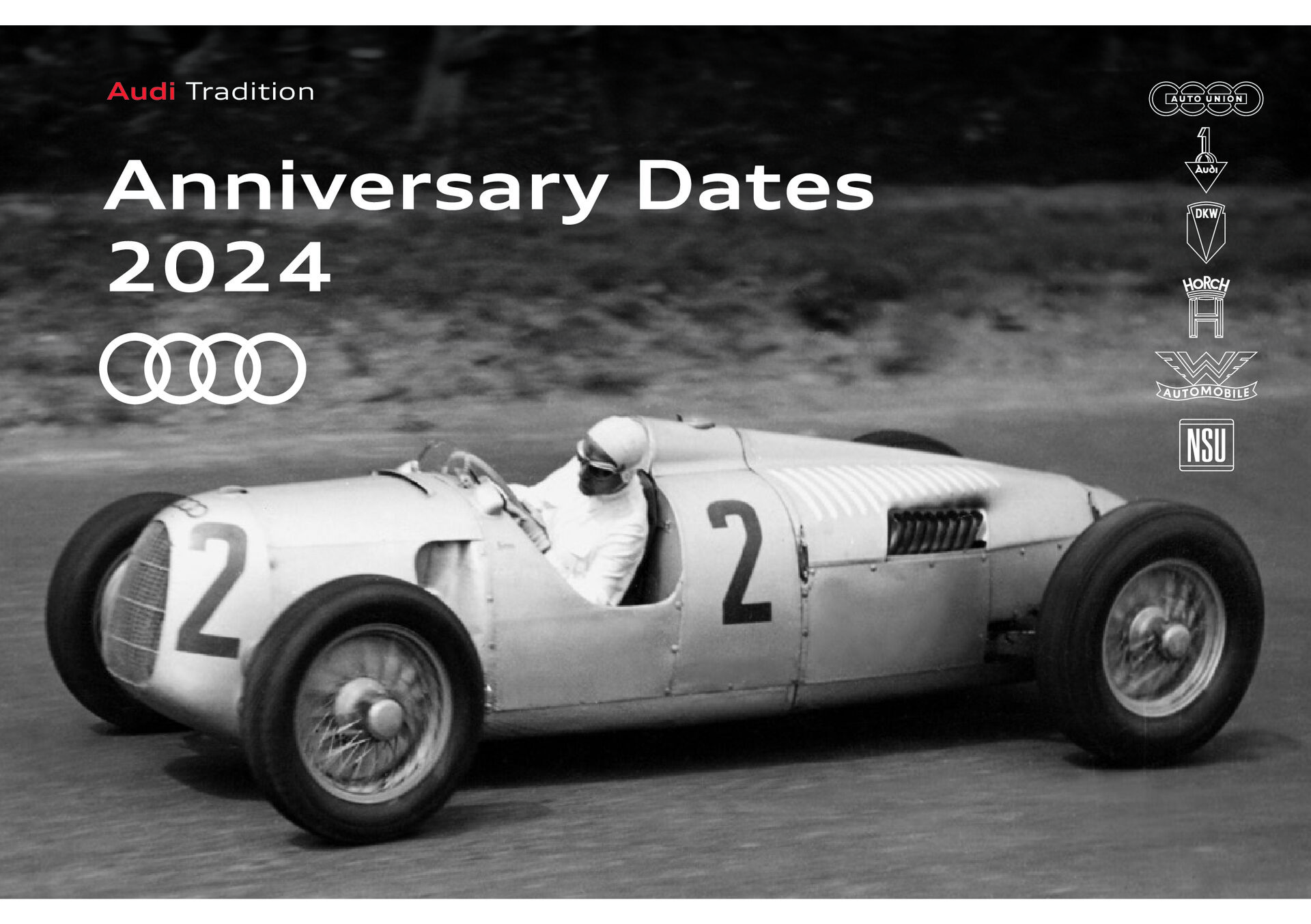 Audi Tradition - Anniversary Dates 2024
Audi Tradition - Anniversary Dates 2024
The merger of NSU and Auto Union to create Audi NSU Auto Union AG sparked rumours that the K 70 would not be built as a product to rival the Audi 100 and VW 411/412. But this did not happen and VW adopted the last new car to be developed in Neckarsulm, getting it ready for production with help from former NSU engineers at the newly constructed plant in Salzgitter within a year. From August 1970 to May 1975, 211,127 VW K 70 rolled off the production line in Lower Saxony. Audi Tradition 18 Anniversary Dates 2024 Takeover of Auto Union GmbH by Volkswagenwerk AG Years 60 1964 was a key turning point for Auto Union in Ingolstadt. In an extraordinary meeting of the shareholders on 16 December 1964, those present decided to increase the share capital from 80 to 160 million DM. At the same time, the acquisition of 51% of the capital by Volkswagenwerk AG, which had been prepared back in October of the same year, received the required approval. The officials thus initiated the gradual takeover of Auto Union GmbH from Daimler-Benz AG (previously the sole shareholder) by Volkswagenwerk AG. The takeover became legally effective on 1 January 1965. The rest of the shares were acquired from Daimler-Benz in further stages. From 1 November 1966, Auto Union GmbH was a fully owned subsidiary of VW. Audi Tradition 19 Anniversary Dates 2024 DKW F 102 The long-awaited successor to the outdated Auto Union 1000 made its debut at the International Motor Show in Frankfurt in September 1963, but only hit the market in March 1964. Hailed as the “Formula of Progress”, the DKW F 102 was a car with a modern design that was noted for its self-supporting body which was a departure from the separate design of chassis and body that had previously been customary at the company. But the grand DKW was still fitted with a three-cylinder, two-stroke engine. It was set to be the final two-stroke passenger car in the company’s history; the last DKW F 102 rolled off the production line in March 1966.
 Audi Tradition - Anniversary Dates 2026
Audi Tradition - Anniversary Dates 2026
Audi Tradition 13 Anniversary Dates 2026 Start of Production DKW Off-Road Vehicle Starting in 1953, Auto Union GmbH began working on the development of a lightweight, all-wheel-drive offroad vehicle. The trigger was confidential information regarding the “vehicle equipment of a future German Wehrmacht,” which the VDA had provided to all German automobile manufacturers under strict secrecy. At the end of 1956, the DKW F 91/4 – its model de signation standing for “DKW F 91 with four-wheel drive” – built at the Auto Union plant in Ingolstadt, was introduced into service with the newly established German Bundeswehr as the standard vehicle in the 0.25-ton payload class. In 1962, the DKW off-road vehicle received the model designation MUNGA, an acronym for “Mehrzweck UNiversal Geländewagen mit Allradantrieb” (multi-purpose universal all-wheeldrive off-road vehicle). With the end of Bundeswehr procurement contracts, production of the last DKW two-stroke vehicle ceased in December 1968 after a total of 46,750 units had been built. 70 years Audi Tradition 14 Anniversary Dates 2026 Death Anniversary August Horch The son of a blacksmith, Dr. August Horch was born on 12 October 1868 in Winningen on the Moselle River. After completing his craft training, years of travel, and studies at the Technical College in Mittweida, Horch joined Carl Benz in Mannheim in 1896, where he accompanied and helped shape the early days of automobile construction as head of the Motor Vehicle Production Department until 1899. In the same year, he set up his own small repair workshop for motor vehicles in Cologne. In 1901, he built his first automobile of his own design. In 1902, he relocated his company to Reichenbach in the Vogtland region, moving again two years later to establish the final location of the Horch works in Zwickau.
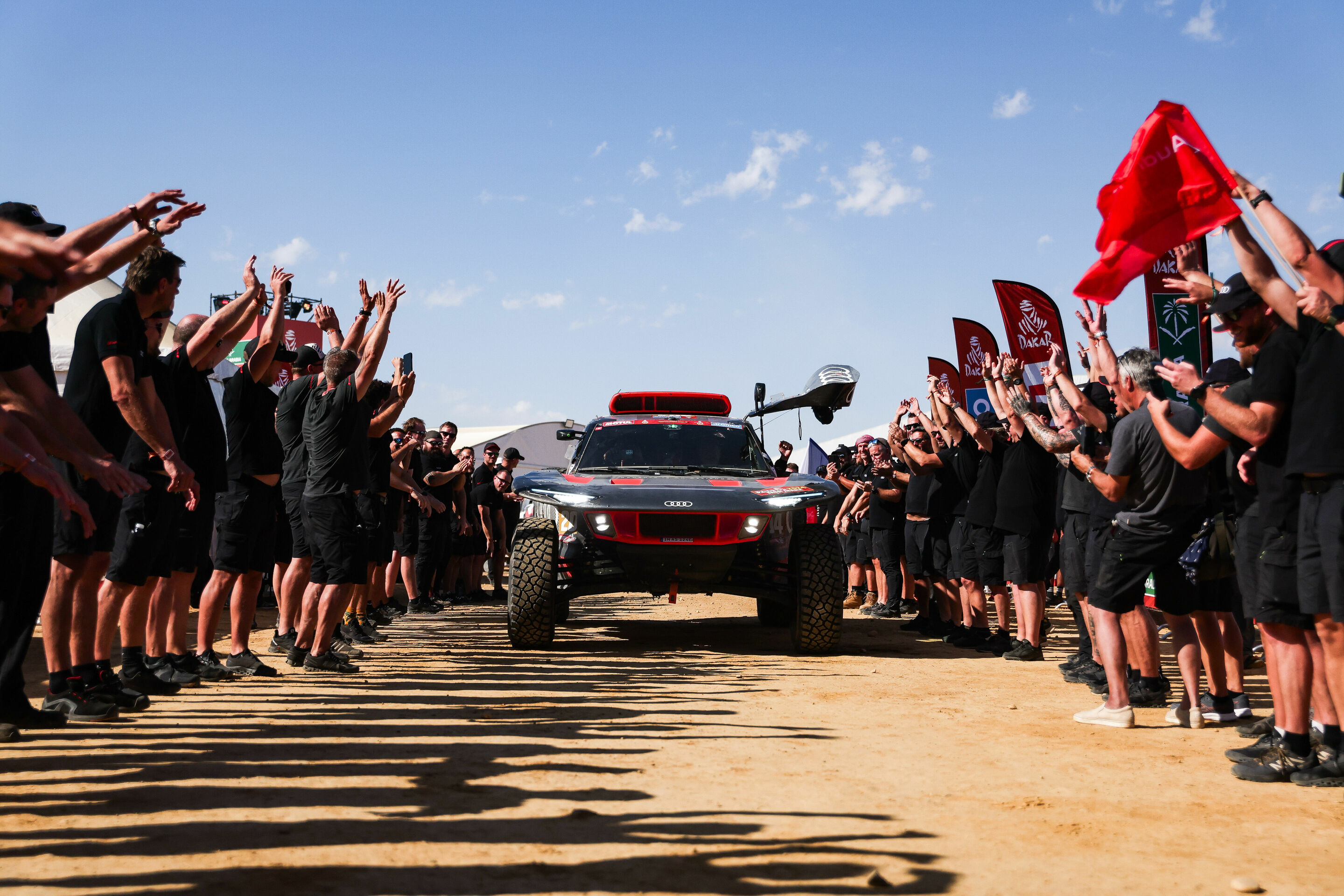 Audi’s most important motorsport successes
Audi’s most important motorsport successes
ultra) Winner Iberian Supercars Trophy (Audi R8 LMS ultra) Winner Spanish GT3 Championship (Audi R8 LMS ultra) Winner GT Cup Macau (Audi R8 LMS ultra) 2011 Winner Drivers classification DTM (Audi A4 DTM) Winner Le Mans 24 Hours (Audi R18 TDI) Winner Spa 24 Hours (Audi R8 LMS) Winner Bathurst 12 Hours (Audi R8 LMS) Winner Italian GT3 Championship (Audi R8 LMS) Winner Spanish GT3 Championship (Audi R8 LMS) Winner Blancpain Endurance Series (Audi R8 LMS) Winner Teams classification Blancpain Endurance Series (Audi R8 LMS) Winner Super Taikyu Series Japan (Audi R8 LMS) Winner GT Cup Macau (Audi R8 LMS) 2010 Winner Le Mans 24 Hours (Audi R15 TDI) Winner German GT Championship (Audi R8 LMS) Winner Belcar Series (Audi R8 LMS) Winner Teams classification Belcar Series (Audi R8 LMS) Winner Portuguese GT3 Championship (Audi R8 LMS) Winner Spanish GT3 Championship (Audi R8 LMS) Winner Teams classification ADAC GT Masters (Audi R8 LMS) 2009 Winner Drivers classification DTM (Audi A4 DTM) Winner Sebring 12 Hours (Audi R15 TDI) 3rd in Le Mans 24 Hours (Audi R15 TDI) Winner FIA GT3 European Championship (Audi R8 LMS) Winner ADAC GT Masters (Audi R8 LMS) Winner Belgian GT Championship (Audi R8 LMS) 2008 Winner Drivers classification DTM (Audi A4 DTM) Winner Le Mans 24 Hours (Audi R10 TDI) Winner American Le Mans Series (Audi R10 TDI) Winner Le Mans Series (Audi R10 TDI) Winner Superstars Series (Audi RS 4) 2007 Winner Drivers and teams classification DTM (Audi A4 DTM) Winner Le Mans 24 Hours (Audi R10 TDI) Winner American Le Mans Series (Audi R10 TDI) Winner Sebring 12 Hours (Audi R10 TDI) Winner Superstars Series (Audi RS 4) 2006 Winner Le Mans 24 Hours (Audi R10 TDI) Winner American Le Mans Series (Audi R10 TDI) Winner Sebring 12 Hours (Audi R10 TDI) Winner Swedish Touring Car Championship (Audi A4 STCC) Winner Teams classification Superstars Series (Audi RS 4) 2005 Winner Le Mans 24 Hours (Audi R8) Winner American Le Mans Series (Audi R8) Winner Sebring 12 Hours (Audi R8) Winner 1000
 Audi Tradition - Anniversary Dates 2025
Audi Tradition - Anniversary Dates 2025
With a total production run of 30,687 units, the Coupé remained a niche choice compared to the Audi 100 sedan, quickly earning a reputation as a car for individualists and achieving collector status early on. 55 years Audi Tradition 18 Anniversary Dates 2025 Reintroduction of the Audi Brand By the mid-1960s, Auto Union GmbH in Ingolstadt faced a crisis with its DKW two-stroke automobiles. Although the front-wheel-drive DKW models received consistent praise for their handling in the automotive press, the three-cylinder two-stroke engine increasingly became a liability. To address this, Daimler-Benz developed a four-cylinder four-stroke engine for its struggling subsidiary, derived from a discontinued military vehicle project. Before the development was completed, Daimler-Benz sold Auto Union GmbH to Volkswagenwerk AG. Under VW management, the project continued. Chief engineer Dr. Ludwig Kraus fitted the newly developed, unusually 60 years Audi Tradition 19 Anniversary Dates 2025 high-compression (11.2:1) four-stroke engine, known as the “medium-pressure engine,” producing 72 hp, into the modified body of the final DKW model, the F 102. The new model, a mix of the DKW F 102 and the fourstroke engine, was named “Audi.” The Auto Union Audi was introduced at the Frankfurt Motor Show (IAA) in September 1965, with production having already begun on August 13, 1965. The Audi name had previously been used 55 years earlier, in May 1910, when the first Audi automobile, the Type A 10/22 PS, designed by Hermann Lange and August Horch, was delivered. Audi production ceased during World War II, with the final Audi 920 rolling off the assembly line at the Horch plant in Zwickau in April 1940. It would take a quarter of a century before the Audi brand made its return. Audi Tradition 20 Anniversary Dates 2025 NSU Prinz 1000 TT and NSU Typ 110 In 1965, NSU fulfilled customer demands for greater sportiness with the introduction of the Prinz 1000 TT.
